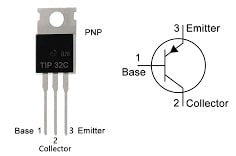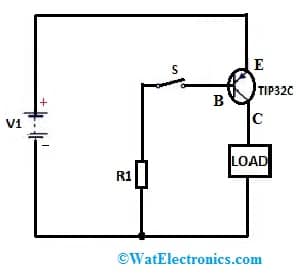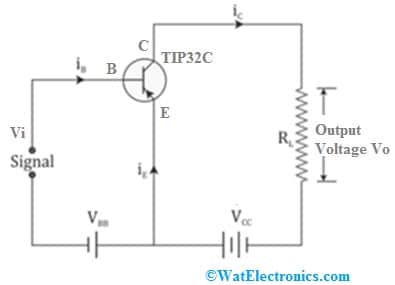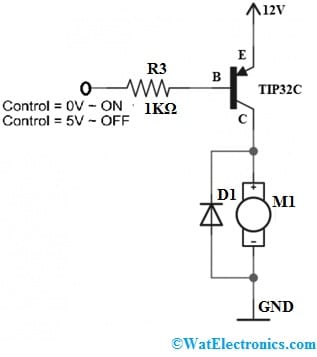A type of transistor that is designed by sandwiching an N-type semiconductor between the two P-type semiconductors is known as a PNP transistor. This transistor includes three terminals like collector, emitter & base. This transistor performs as two PN junction diodes connected end-to-end. These end-to-end PN junction diodes are called the collector-base (CB) junction & base-emitter (BE) junction. There are different PNP transistors which are manufactured by different manufacturers like TIP32C, TIP32A, TIP42, TIP42C, and many more. This article discusses an overview of a low-power PNP transistor like the TIP32C PNP Transistor which can be used in switching & amplification-based applications.
What is TIP32C PNP Transistor?
The TIP32C is a PNP power transistor with a silicon Epitaxial-base available in a TO-220 plastic package. This transistor is mainly used in switching & medium power linear applications. The TIP32C PNP transistor handles 3A of maximum load, 5A of maximum peak current, and 100V of maximum load voltage. The TIP32C transistor can also be utilized as an amplifier.
A 40W of maximum dissipation of collector current will make it perfect for audio amplifier stages & as a separate amplifier to drive the speaker. TIP32C transistor has high current gain & collector current, so it is quite easy to control the device since it has only 5V of Emitter-Base voltage & 120mA of base current only.
Since we are dealing with this TIP32C PNP Transistor with a high current, a heat sink is recommended for good heat dissipation in switching applications.
Pin Configuration:
The pin configuration of the TIP32C PNP transistor with a symbol is shown below. This transistor includes three pins and each pin is discussed below.

TIP32C PNP Transistor Pin Configuration
- Pin1 (Base): This pin is used to control the transistor biasing by turning ON/OFF the transistor.
- Pin2 (Collector): This pin allows the flow of current and it is usually connected to a load.
- Pin3 (Emitter): This pin drains out the flow of current and it is usually connected to GND.
Features & Specifications:
The features and specifications of the TIP32C PNP transistor are discussed below.
- The type of Mounting is Through a Hole.
- It is available in TO-220-3 Package.
- The operating temperature is 150°C TJ.
- MSL or Moisture Sensitivity Level is 1 (Unlimited).
- The power Dissipation Maximum is 40W.
- Single Element Configuration.
- The type of Transistor is PNP.
- Collector Current (Max) is -3A.
- Cutoff Current – Collector (Max) is 300μA.
- Collector-Emitter (CE) Saturation Voltage is -1.2V.
- Emitter Base Voltage orVEBO is -5V.
- Junction Temperature or Tj (Max) is 150°C.
- Number of Pins – 3.
- The element Material is SILICON.
- Tube Packaging.
- Collector Base Voltage or VCBO is -100V.
- The current Rating is -3A.
- The transition Frequency is 3MHz.
- Voltage from Collector to Emitter or VCEO is -100V.
- The breakdown Voltage from Collector Emitter is 100V.
- The gain of DC Current or hFE is 10 to 50.
Equivalent & Replacement TIP32C Transistors
The equivalent TIP32C PNP transistors are; CJF32C, BD582, TIP32D, BD592, 2N6475, BDT32C, 2N6476, MJE30C, 2SB1016, MJE32C, NSP582, MJE5195, NSP5195, RCA32C, RCA30C, TIP62A, TIP62C, TIP62B, 2SB761B, 2SB860, 2SB762B, 2SB869, BD242C, 2SB945, BD540C, ECG292, BD954. For the replacement TIP32C transistors if you drive the load below 40V or 80V then you can use exact match transistors TIP32B, TIP32A, etc. TIP32A transistor drives loads below 60V & TIP32B transistor can drive loads below 80V.
TIP32C PNP Transistor as a Switch
In electronic circuits, the basic transistor application is a simple switch. Once the voltage is applied to the base terminal, then the transistor conducts current from the collector (C) to the emitter (E) channel. When the switch is turned off then there is no base voltage is applied to the transistor. Similarly, when the switch is turned on then the base voltage is applied to the transistor.
The TIP32C PNP transistor as a switch circuit is shown below. This circuit can be built with basic components like a 470 resistor, TIP32C, voltage supply, switch, and load. Connect the circuit as per the diagram shown below.

TIP32C PNP Transistor as a Switch
The resistor in the above circuit restricts the flow of current. The TIP32C is a PNP transistor and it is complementary to the TIP31C transistor. This is a basic PNP transistor where the switch is connected to the base of TIP32C, the emitter is connected to the supply voltage and the collector terminal is connected to the load.
The switch in the above circuit decides whether the current flows to the base terminal or not. When this switch is closed then it activates the PNP transistor and it allows to flow the current throughout the load.
In this switch circuit, the TIP32C PNP transistor works like a TIP31C transistor in terms of switching, however the current supplies from the base terminal. The transistor’s base terminal is negatively biased always with respect to the emitter terminal. The load in this circuit is connected to the switching output of the transistor with a reference point. Once the transistor is triggered, the current flows toward the load & finally to the GND.
TIP32C PNP Transistor as an Amplifier Circuit
The main characteristic of a transistor is, it can be utilized as an amplifier. When the transistor is properly biased or works in the active region then it functions as an amplifier. A transistor as an amplifier plays a key role in increasing or amplifying the input signal in any application. The TIP32C PNP transistor as an amplifier circuit is shown below.

TIP32C PNP Transistor as an Amplifier
The VBB battery in the above circuit forward biases the emitter-base (EB) junction & the VCC battery reverse biases the emitter-collector (EC) region. The batteries e.m.f. must be higher as compared to the barrier potential across both the junctions like collector-emitter & base-emitter. The output current generates a potential difference across the load resistance ‘RL’.
In this circuit, the transistor uses a very small weak signal throughout the base junction of the transistor & provides the amplified signal throughout the collector. Transistor as an amplifier is mainly used in optic fiber communication (OFC), audio amplification, radio frequency (RF), etc. Amplification is a significant step in various applications like MP3 players, wirelessly transmitted signals, mobile phones, wirelessly received signals, etc. The transistor at different configurations may increase voltage, current & power.
TIP32C PNP Transistor as a DC Motor Driver
The circuit diagram of the TIP32C PNP Transistor as a dc motor driver is shown below. In the following circuit, the base of the transistor is our input, the emitter terminal is connected to a constant voltage and the collector terminal is connected to the load on the ground side.

DC Motor Driver
In the above circuit, TIP32C PNP Transistor can be used to drive & control the DC motor speed by switching the transistor in the circuit at regular time intervals. We can turn ON & OFF the DC motor repeatedly by switching the transistor in the saturation & cutoff regions.
Generally, PNP transistors are turned ON unless the applied signal to the base terminal is high. So, when the base terminal gets a high signal, your DC motor will be turned OFF. However, when the base terminal gets a low signal, the motor will be turned ON.
How to use TIP32C Transistor Securely in a Circuit?
To use the TIP32C transistor in a circuit very securely, do not drive load above 3A & 100V. Always utilize an appropriate heat sink, the collector terminal is also connected to the metal tab so care should be taken while using it in your circuit or design otherwise it can harm the PNP transistor. It is always operated or stored at a temperature that ranges from -65 C to +150 C.
Applications
The applications of the TIP32C PNP transistor include the following.
- The TIP32C PNP transistor is used as an amplifier.
- This transistor is very useful in driving LEDs, DC motors, bulbs, relays, etc.
- It is also used in the output of raspberry pi, Arduino & other platforms.
- It is used in high-current switching loads up to 2A.
- It is used in large signal amplification.
- It is used in half-bridge circuits.
- It is used in Inverters & other rectifier circuits.
- It is used to control the speed of motors.
- This transistor is used as a medium power switch.
- It is used in linear & switching industrial equipment.
- It is used as a medium power switch.
- It is used in several general audio & other signal amplification supplies.
- This transistor can be used with a microcontroller in a H-Bridge circuit. So, please refer to this for Precautions to be taken while connecting a Transistor to Microcontroller.
Please refer to this for How to Select a Transistor.
Please refer to this link for TIP32C PNP Transistor Datasheet.
Thus, this is all about an overview of the TIP32C PNP transistor – features, specifications, and its applications. The TIP32C is a silicon Epitaxial-base PNP transistor. It is mainly used in medium power switching & linear applications. The complementary of this transistor is the TIP31C NPN transistor. Here is a question for you, what is an NPN transistor?